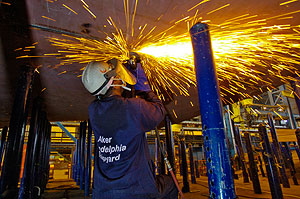Chapter 20 talks a lot about Hawaii. There is a section that talks about tourism in Hawaii and how it all started. The book states "It has proved successful and provided profit for globalized business concerns, but only for short term. The total dependence on tourism and fossil fuels is a questionable formula in the twenty-first century" (553). Tourism became big in Hawaii once the plane prices began to lower so that it was more affordable for people to visit. The beaches are very known in Hawaii because it is very beautiful. This section of the book relates to my city Philadelphia, PA because there are a lot of tourist people that go to see all the historical buildings. One place that a lot of tourist people love to see in Philadelphia is the Art Museum. Some people want to see it because of the Rocky Movie (the big stairs), but others just want to see it for historical reasons.
Philadelphia Art Museum
The Philadelphia Art Museum is on of the largest art museum in the United States. A lot of people from around the world love to visit this famous Museum. It holds collections of more then 227,000 objects that includes world class holdings of European and American paintings, prints, drawings, and decorative arts. The main building is visited by more than 800,000 people annually, and is located at the west end of Philadelphia's Benjamin Franklin Parkway. As a child living in Philadelphia, I have to say I visited this museum at least twice a year. The exterior and interior of this building is very beautiful. Below is a short YouTube clip explaining how important the Art Museum is to Philadelphia.
Lastly, while there's great places to be seen in both Hawaii and Philadelphia, there are other important things that are going on. The book also explains how Hawaii Islands face the same urban ills as the rest of the nation. Drugs, high crime rates, lack of good water, a growing prison population, and failing educational systems is the problems Hawaii faces. This really relates to Philadelphia because all of these problems are the same problems that is occurring in Philadelphia to this day. No one really knows how to fix all of these problems to make the city a better place. Below are two photos of the crimes in both Hawaii and Philadelphia. As we can see the numbers are starting to decrease but in Philadelphia, the numbers are beginning to rise again. So while there's positive things about both places there are also the negatives.
Hawaii Crimes
Source:
Mayda, Chris. A Regional Geography of the United States and Canada: Toward a Sustainable Future. Lanham, Md: Rowman & Littlefield, 2013. Print.
www.google.com (Google images)
www.YouTube.com








.jpg)








.jpg)











